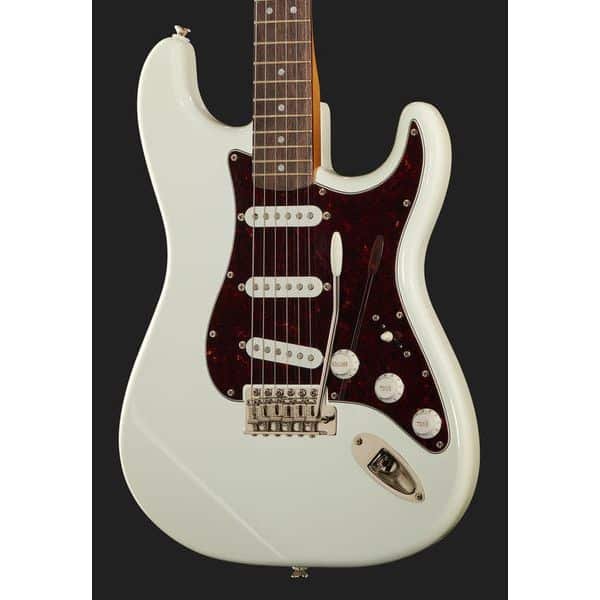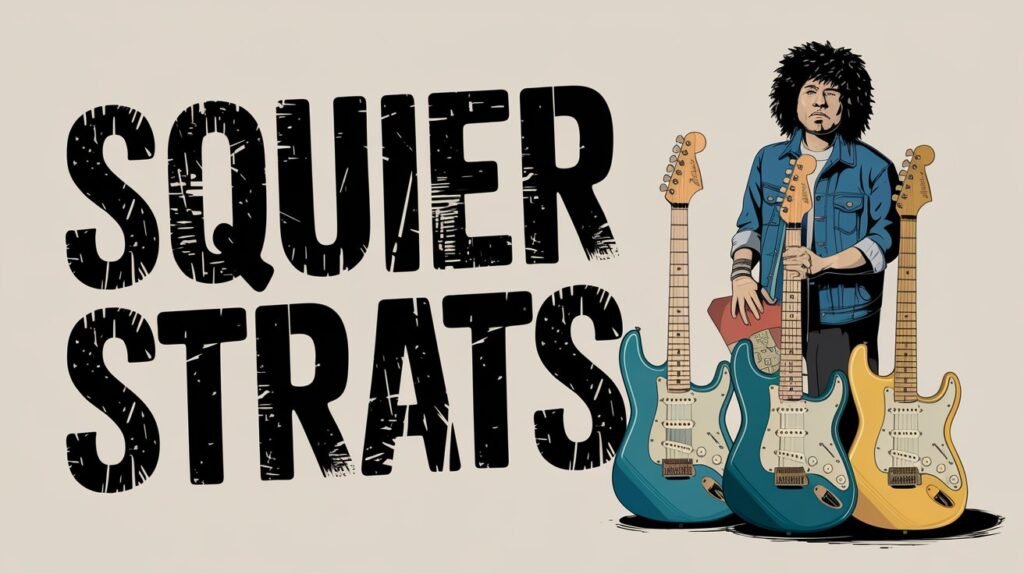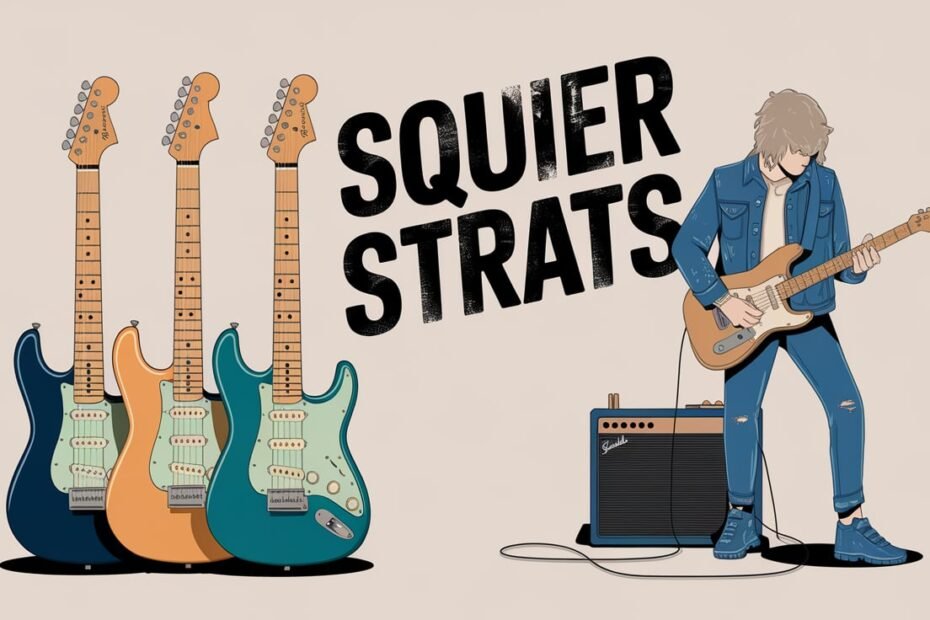Okay, so you’re here because you’re eyeing a Squier Classic Vibe Strat but can’t decide between the ’50s, ’60s, and ’70s models.
I get it—there’s a lot to consider. I’ve spent time with all three of these guitars, so I’m here to break it down for you.
These Squier Classic Vibes are, honestly, a great bang for your buck. And yes, I’ve tested all these guitars myself, so you’re getting the real deal from someone who’s had their hands on them.
Squier Classic Vibe Stratocaster – 50s vs 60s vs 70s
Let’s just get right into it. Here’s a quick comparison of the most important features between the ’50s, ’60s, and ’70s Strats.
I also threw in my ratings because why not? Spoiler alert: The ’50s is my top pick.
You can also listen to the podcast discussion about these guitars via Spotify below.
| Feature | ’50s Strat | ’60s Strat | ’70s Strat |
|---|---|---|---|
| Body | Pine | Nato | Poplar |
| Neck | Maple | Maple | Maple |
| Fingerboard | Maple | Indian Laurel | Indian Laurel |
| Pickups | Alnico Single Coils | Alnico Single Coils | Alnico Single Coils |
| Pickguard | Single-Ply White | 3-Ply Parchment | 4-Ply Tortoiseshell |
| Color | 2-Color Sunburst | Candy Apple Red | Olympic White |
| My Rating | 10/10 | 9/10 | 9/10 |
| Thomann Price | See on Thomann | See on Thomann | See on Thomann |
| Sweetwater Price | See on Sweetwater | See on Sweetwater | See on Sweetwater |
Squier Classic Vibe ’50s Stratocaster
The ’50s Strat? It’s like finding a hidden gem in a dusty old record shop. This guitar’s got a pine body and a maple neck that feels like it’s been around forever but somehow still feels fresh.
The two-color sunburst finish just screams vintage—like something straight out of the golden age of rock ‘n’ roll. When you hold this thing, it’s almost like you’re holding a piece of history.

Now, let’s talk about the neck. It’s a C-shaped maple neck with a maple fingerboard, and it’s as smooth as butter.
The pickups—Fender-designed Alnico single coils—deliver that classic Strat tone you’ve heard a million times. Whether you’re playing clean or dirty, this guitar handles it all.
And it’s light too, so you won’t feel like you’ve been lugging a tree trunk after a long session.
Key Features
- Body: Pine
- Neck: Maple with a maple fingerboard
- Pickups: 3 Fender-designed Alnico single coils
- Pickguard: Single-ply white
- Color: 2-Color Sunburst
My Sound Demo
My Experience
Playing the ’50s Strat feels like slipping into your favorite pair of jeans. It’s comfortable, familiar, and just makes you want to keep playing.
The tones are bright, especially in the 2nd and 4th positions on the switch. The neck? Super comfortable, letting you glide up and down with ease. The vintage-style tremolo is great for adding those subtle vibratos or going full-on Hendrix.
Trust me, you’ll want to plug this into a good amp to really let it shine. For more on how this baby sounds, check out my reviews on Best Guitars Now and Strefa Gitar.
Squier Classic Vibe ’60s Stratocaster
The ’60s Strat takes you back to a time when rock was evolving, getting more soulful. With a Nato body and an Indian laurel fingerboard, this guitar has a tone that’s a bit darker, warmer than the ’50s model.

The Candy Apple Red finish is a showstopper—it’s the kind of guitar you’d want to be seen with, on stage or off.
This neck’s still got that familiar C-shape, but with the laurel fingerboard, the sound is a bit softer, a bit more rounded.
The Fender-designed Alnico single coils are still there, but they give you a sound that’s a bit more laid-back, perfect for blues or that classic rock vibe.
If the ’50s Strat is all about that sharp, biting tone, the ’60s model mellows things out a bit, with more body in the sound.
Key Features
- Body: Nato
- Neck: Maple with Indian laurel fingerboard
- Pickups: 3 Fender-designed Alnico single coils
- Pickguard: 3-ply parchment
- Color: Candy Apple Red
My Sound Demo
My Experience
The ’60s Strat feels like wrapping yourself in a warm blanket. It’s comfortable and cozy, with tones that are smooth and rich.
This guitar’s weight is more noticeable, especially after a long session, but it’s worth it for that warm tone. The Candy Apple Red finish is a head-turner, no doubt about that. If you’re into more melodic playing, this Strat has got your back.
It’s got a bit more soul than the ’50s model, and it’s perfect for those who like their sound a bit warmer, a bit deeper.
Squier Classic Vibe ’70s Stratocaster
The ’70s Strat? It’s like stepping into a time machine set to the golden age of classic rock. It’s got a Poplar body and a 4-ply tortoiseshell pickguard that just screams ’70s rock. The Olympic White finish is pure class—this guitar looks like it’s ready to rock arenas.

The neck? Still maple, still C-shaped, with an Indian laurel fingerboard. But this time, it’s a bit chunkier, which some players will dig.
The Fender-designed Alnico single coils are back, but they’ve got a bit more heat under the hood, perfect for cranking up the distortion. It’s got more bite, more attitude—like it’s daring you to play it louder.
Key Features
- Body: Poplar
- Neck: Maple with Indian laurel fingerboard
- Pickups: 3 Fender-designed Alnico single coils
- Pickguard: 4-ply tortoiseshell
- Color: Olympic White
Sound Demo
My Experience
The ’70s Strat is a rock machine, plain and simple. It’s got a bit more edge, and the chunkier neck makes it feel more solid in your hands.
If you’re into classic rock or even dipping your toes into early metal, this guitar’s got the firepower to handle it. The Olympic White finish paired with that tortoiseshell pickguard is a killer look—this guitar isn’t just for playing; it’s for showing off.
It’s got more grit than the other two models, and if you’re after something with attitude, the ’70s Strat might just be your new best friend.
Which Was My Favorite?
So, out of the ’50s, ’60s, and ’70s models, which one stole my heart?
Hands down, it’s the ’50s Strat. There’s just something about that bright, snappy tone and lightweight body that makes it a joy to play.

It’s the kind of guitar that you pick up intending to play for 10 minutes, and then two hours later, you’re still jamming. The other two models are great, don’t get me wrong, but the ’50s just hits the sweet spot for me.
Don’t get me wrong though – other models are fantastic too! I guess I just love maple fretboards 🙂
I had the sunburst version, but there’s also white blonde version too which looks sick IMO.

Fender vs. Squier
Now, let’s talk about something that’s been a debate forever—Fender vs. Squier. You hear it all the time: “Fender is the real deal,” or “Squier is just a cheap knock-off.”
Well, I’ve played both, and let me tell you, Squier has really stepped up, especially with the Classic Vibe series.
I compared a lot of Fenders and Squiers on my channel. Not only Strats – but also Telecasters and Jazzmasters (as you can see below).
What’s funny, some Fender guitars have nuts made of plastic. And at the same time, CV Squiers have bone nuts! This is nuts (no pun intended).

Sure, Fender has that name and prestige, but when you’re playing a Squier Classic Vibe, you’re getting a guitar that’s probably 80-90% of the Fender experience at a fraction of the cost.
The differences? They’re there, but they’re not huge. Maybe the finish is a bit nicer on a Fender, maybe the pickups are a tad more refined, but in the heat of the moment, when you’re playing your heart out, it’s not gonna matter much.
So if you’re not really sure if not having Fender logo on the headstock is worth it? Well, it is.
Don’t believe me? Check out my full comparisons and reviews on my YouTube channels, Best Guitars Now and Strefa Gitar. You’ll see what I mean.
Where To Buy These Strats?

So, you’ve figured out which Squier Classic Vibe Stratocaster you want—now, where should you buy it? If you’re in Europe, I recommend checking out Thomann.
They’re known for being reliable, with great customer service, and they have a wide selection of guitars. Plus, they package everything super well, so you don’t have to worry about your new guitar getting damaged on its way to you.
Also I love the fact that they give you a 3-year warranty.
If you’re in the U.S., my friends always recommend Sweetwater. They’re famous for their excellent customer service, and they even include some candy with your order, which is a nice little bonus. They also offer free shipping, and they make sure your guitar arrives safely and in perfect condition.
So, whether you’re in Europe or the U.S., these are great places to buy your new Classic Vibe Strat.
FAQ
1. Are the Squier Classic Vibe guitars good for beginners?
Yes, definitely. They’re well-built, sound good, and won’t break the bank. Plus, they’re easy to play, which is super important when you’re just starting out.
2. How do the Squier Classic Vibe models compare to Fender Strats?
The Classic Vibe series gets you close to that Fender experience without the hefty price tag. The build quality and tones are impressive for the price.
3. What’s the difference between the ’50s, ’60s, and ’70s models?
Each model has its own vibe. The ’50s Strat is bright and snappy, the ’60s is warmer and richer, and the ’70s has more bite and aggression.
4. Can I gig with a Squier Classic Vibe?
Absolutely. These guitars are built to last and can handle live performances just fine. Just make sure you’ve got a good setup.
5. Are the necks on these guitars comfortable to play?
Yes. The C-shaped necks are easy to play, whether you’re a beginner or an experienced guitarist. Each neck has its own feel, so it’s worth trying them out to see which one you prefer.
6. How does the weight compare between the different models?
The ’50s model is the lightest, thanks to its pine body. The ’60s and ’70s models are a bit heavier, but still manageable for most players.
7. Do the Squier Classic Vibe guitars stay in tune well?
They do. The vintage-style tuners are reliable, and the bone nut helps with tuning stability. Just make sure you keep it properly set up.
8. Should I upgrade the pickups on these guitars?
The stock pickups are solid, but if you’re after a specific tone or just want to experiment, upgrading the pickups could be worth it.
Read Polish review of Squier Classic Vibe Strat.
Final Thoughts

The Squier Classic Vibe ’50s, ’60s, and ’70s Stratocasters are all fantastic options, each with its own unique flavor.
Whether you’re after the bright and lively tones of the ’50s, the warm and soulful sound of the ’60s, or the punchy, aggressive vibe of the ’70s, there’s something here for everyone.
These guitars give you a lot of bang for your buck and are solid options whether you’re just starting out or looking to add another Strat to your collection.
Still not sure? Check out my in-depth reviews on my YouTube channels, Best Guitars Now and Strefa Gitar, to see these guitars in action. Trust me, once you hear them, you’ll understand why the Classic Vibe series is so well-loved.





